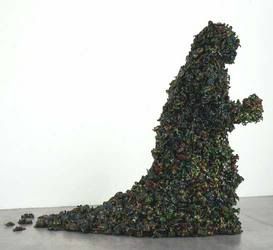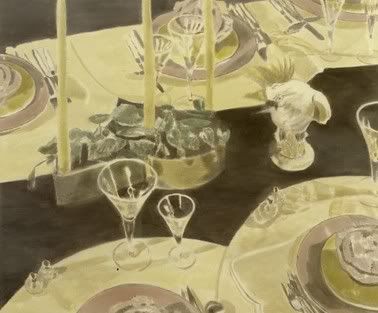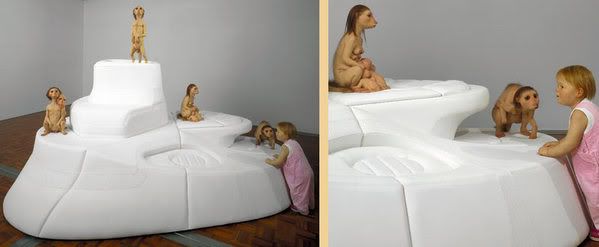Much later, sometime after our cellphones lost an hour, I stood outside a party on Bond Street, quite drunk, talking with a good friend about nothing. I mentioned something about painting and he placed a hand on my shoulder, as much to dramatize what he was about to say as to steady himself. "You know what you do is bullshit, right? I mean, it's all irrelevant. No one cares about painting or art anymore. You recognize this, right?" I do, of course I do. The Art World has withdrawn from society in the same way that academia, the theater or opera has. These are now esoteric arenas, marginalized - even pilloried - in the eyes of "the people." My friend continued, "I mean, it's not just painting or fine art. The same is true of classical music. These are mediums that screwed themselves. It's not your fault the Art World made itself irrelevant but, because of that, you're making irrelevant work." Fortunately, I was too drunk to sit on his dose of downer realism and I returned to the party no worse for the wear, if three sheets to the wind.
The next morning, I woke with a headache, dehydrated calf muscles and the memory of my friend's words. I had so easily brushed them aside when drunk, but I was now forced to retreat, to delay the confrontation, by rolling over and welcoming more sleep. I so wanted to wake up, to go into the studio and have a productive Sunday, but the knowledge that "no one cares" was too present, a cartoon thunderhead hanging above my pillows in an otherwise bright, sunny room. When I finally did rise, reluctantly, I wandered into the kitchen, fed my cat, put on some water for tea and ate a banana while I stared out the window and played with my belly hair. Banana finished, water not yet rolling, I decided I had better head to the toilet for some overdue release. On the way, I paused to lean against the frame of the studio door and survey the paintings in progress. Elation! Thirty seconds of looking was all it took; I was renewed. The thunderhead evaporated in the warm light and I made my way to the toilet free of worry about the irrelevance of contemporary art. After all, art is not at all irrelevant to me.
+++++++++++++

Nancy Margolis: Kim Simonsson's ceramic sculptures are really cool looking. I love his - Kim is a him - sculpture of a doe-eyed manga troublemaker allowing a string of spit to hang down from her pursed lips. I'm also attracted to the two fawn pairings in the rear of the gallery. But so what? These are well executed, fun sculptures, but they leave me wanting a more substantial experience. Simonsson's artist statement suggests that he is interested in exploring contemporary societal ills by producing work that "call[s] forth questions" while "blur[ring]the distinction between traditional art and popular culture." Well, don't we all aim to produce such work? Personally, I think he just likes making really cool looking sculptures.
+++++

Metro Pictures: I want to like Jim Shaw's work, but I rarely do; his latest New York solo effort is no exception. One of my friends liked the green-tinted resin sculpture at the back of the main gallery space, but it reminds me too much of my own art school resin fetish. Shaw melted and glued toys and colorful plastics together to produce a human-slug hybrid that calls to mind the Toxic Avenger or the Trash Heap from Fraggle Rock. Like the rest of this show, which features painting, drawing, sculpture and one marriage of painting and installation, this piece can't be called bad, but it is boring.
+++++

Luhring Augustine: Ever since I saw the original Star Wars, I have been interested in designing my own chess set. Whether populated by holographic alien beasts (as in George Lucas's imagining), wizards, animal species or street gangs, I've always gotten a kick out of "alternative" boards and players. Unfortunately, my half-hearted attempts - usually Sculpy creations - never turned out as I desired; maybe one day, somewhere over the rainbow, I'll have enough money at my disposal to design a set I really love. I was pleasantly surprised, then, by "The Art of Chess," a group show at Luhring Augustine featuring ten artist designed chess sets. Alas, we are all individuals and most of these sets belong to another's sensibility. For example, Rachel Whiteread casts her collected dollhouse furniture and uses the sofas, chairs, and nightstands as player stand-ins. The board is comprised of squared carpet samples. I thought it colorful, but subjectively uninteresting and, more importantly, far from pragmatic. It would be difficult to distinguish king from rook or queen from pawn when each piece is distinct, both in terms of color and design. To make things more confusing, there are no repeated forms; rather than having one design for bishop or knight - a recliner, say - all four knights are different items of furniture. I didn't get the sense that Whiteread intended the set to be used for a real game.
There were two chess sets, however, that I though tremendous. Maurizio Cattelan created a "Good & Evil" set (pictured above), featuring delicately crafted players from diverse backgrounds. Hitler stands at attention on the evil side, while Martin Luther King, Jr. and Jesus stare back at him, unintimidated. Again, this set suffers for being a little difficult to play with - without a cheat sheet, it is hard to remember which pieces are what - but it is sexy enough to have me salivating. Good looking and pragmatic, the Chapman brothers present us with a slightly disturbing version of the classic chess set. Each side is coordinated by skin tone - one side Caucasian, the other black - and all players are penis-nosed pubescent girls, some riding on the backs of their friends. Here at last is a set that repeats forms for the respective pieces, making this the most playable set in the exhibition.
+++++

Goff + Rosenthal: Reproduced in an advertisement for his exhibition, Stephen Bush's paintings caught my eye. In person, however, I am ambivalent. The swirls of abstract color seem arbitrary and the representational elements - cabins, bridges or other constructed forms - don't speak to human isolation or individualism in the way I thought they might when flipping through the pages of Art Forum. That said, I get the feeling that Bush is heading toward a more thoughtful body of work.
+++++

David Zwirner: The biggest dud of the day was the Luc Tuymans show at Zwirner. According to the press release, these new paintings "[put] forth the image of a fragile America and the crumbling state of current affairs," but one of my friends described the pale paintings more colorfully: "This is too bland even to be hotel art." I can't help but agree.
+++++

Charles Cowles: I have been enamored of Edward Burtynsky's large-scale photographs for years now. His subject matter - sprawling industry, scarred natural landscapes, urban development - has become standard issue Art World fare, particularly among the younger photographers finding favor in the press, but Burtynsky turned his viewfinder on these subjects years ago and he produces more powerful, meditative images than the majority of his imitators. This selection of photographs from China showcases his eye for color and composition and his instinct for isolating emotional heft in landscape.
+++++

Robert Miller: I've been eagerly awaiting Patricia Piccinini's current solo show for several months and, though it doesn't disappoint, it is a mixed bag. The included photographs and video are very weak, but most of the sculptures and several of the drawings are as satisfying as they are grotesque. Continuing her investigation of genetic anomalies and fringe hybrid experiments, Piccinini presents viewers with a new cast of characters. My favorites are featured near the front of the gallery; part mole rat, part flying squirrel, part gopher, these intimidating little beasties apparently like to attack human faces. Close inspection of the back pouches on her "Surrogate" creature, in the rear gallery, will revolt many gallery visitors. Piccinini's attention to detail is admirable, on par with that of Ron Mueck, and I like her subject matter a lot. She does need to be careful, however, to avoid transitioning into a prop artist. The series of photographs turns some of her creations into just that - they harass construction workers or watch NASCAR on a fence - and, frankly, they look awful. Piccinini is no Hollywood special effects whiz and attempting such a series calls to mind Charlie White, an artist who should have gone into B-movie production where his talents would have been put to better, more complete and gratifying, use. (The image of Piccinini's work seen above is not current. The Robert Miller website is awful.)

8 comments:
I have to ask HH, just what it is your friend does that the world would stop turning without; lawyer, accountant, priest? The people who say things like that don't have any little demons on their back poking them to produce anything except money. I'll tell you right now that his thoughts should be irrelevent to you. I'm not trying to put your friend down, just in perspective. We can all be replaced in the big picture without so much as hiccup. Keep doing what you love.
OGeorge:
Usually your assumptions would be safe, but in this case the friend breaks the rule. He's a musician and one, I believe, with a demon of his own.
I think his comments were inspired by his own existential wrestling match with questions of purpose and moral duty. But as you suggest, the big picture can erase any and all effort easily, and too much focus on the "long run" can overwhelm a thoughtful person, pushing them toward nihilism. I've spent so much time sliding down that road...but I learned to follow the switchbacks and climb right back up. You don't need to worry about me giving up art...once bitten and all that jazz.
I think we must be careful not to fall for the "gold old days" thing; we think that fine arts were more present in the past because what we know from the past was written by the high classes and educated people.
I'd bet that on a total population ratio, fine arts are as popular now than every, if not more. And because of modern communications, tools and the population explosion, a lot more people have a chance to see/hear/read your work than ever before.
Devo:
Wow...well said. I agree with you, but only to a point. The "cultural pace car" description is an excellent one, but I feel the missteps of the Art World (and the academy) have resulted in a second, interior track, one reserved for the pace cars. The pacers do pull onto the main loop now and again, but much of the time the two worlds do not overlap.
Furthermore, the cultural pace cars are usually built by those artists who strive for the "new." While this isn't bad, I think the contemporary, pluralistic creative worlds provide new challenges to the pace car analogy. It is unfair, for example, to critique Wilco and Blackalicious in the same way - the sound of each group is very different - even though both groups produce excellent music by refining (or giving their personal spin on) existing musical genres. Neither of these groups will be future cultural leaders in the same way that The Beatles, The Rolling Stones, or Miles Davis were.
And therein lies the problem. In my opinion, the best contemporary fine art does exactly what you describe in your second paragraph, but the artists often look to refine, edit or provide a new angle on existing structures rather than build/create new ones. This is a good thing, as the modernist trajectory - herald, replace, herald, replace, herald, replace, then worship in masoleum - is long overdue an overhaul. Unfortunately, the transition period - the present - is very uncertain...
Mikhail:
...which brings me to the idea of a "Golden Age" of this or that artform. While I agree that it is essential that we realize culture is dictated by the passage of time and tastes, I do think certain modes of artistic communication are threatened. Painting and sculpture, in particular, are curious mediums in that the creators of these works have been beholden (or at least attached to) institutions of support (and the aristocracy) for hundreds of years. (For this reason, art history classes should be requisite for history and political science majors (and vice versa); artwork nicely reflects the zeitgeist and monied interests, providing scholars with an opportunity to dissect class relationships and philosophical currents of the day.) But opera and classical music are fading artforms. I say this as someone who is friends with both opera singers and conductors/composers; they would agree, even if embittered. Given your own musical tastes, I'd be interested in hearing your thoughts on this.
In some respects, your assertion that fine arts are as popular as ever is correct. The art market is booming right now, and has been for some years. But I dare say most people, even educated people, don't know many contemporary artists. My parents don't know of any, most of my friends couldn't name one (well, maybe Damian Hirst and Christo)... More importantly, most educated people can not even describe a contemporary artwork - the artist's name, after all, doesn't really matter.
Devo:
Absolutely. I fear your assessment is accurate and, for the record, I didn't mean to imply that the Stones or Miles Davis are true revolutionaries, completely original in their art making. Any great innovator is necessarily building on that which came before. As we often hear, there is nothing new under the sun. However, the legacy of such individuals ensures that their work becomes the mortar and stone passed on to future generations. Blackalicious, Tool, Wilco, and Aphex Twin are less likely to be heralded in the way some of their well known predecessors were and, as a result, their artistic influence will be less general, more isolated to specialized or focused communities.
Of course there isn't necessarily anything wrong with such localized influence, but it does move toward a more fractured world. Whereas Jackson Pollack once posed heroic on the cover of Life, now he would only find space on the cover of ArtForum. Very rarely do the specialized worlds enter into the mainstream. As you know, I am a proponent of E.O. Wilson's consilience, his clarion call for reconciliation between seemingly disparate disciplines. As we learn more and more, however, it is increasingly difficult to be a Renaissance man (or woman) without bastardizing some of the facts or trending toward specialization without intending to do so.
At heart, I think you're right. We will find a way to integrate the worlds, to make art - in any field - more relevant and meaningful to "the masses," but I do wonder at the cost. Perhaps I am old fashioned, but my values are rarely reflected in pop culture (sure, I like some pop, but this doesn't mean it has depth or substance); will the marriage of pop culture and depth in the arts be one that propells us all to a better world?
HH:
I agree with what you said. I think that there is a dichotomy between the creation of art (fine or otherwise) and the "appreciation" of it.
You make good points about painting and sculpture. As for classical music, I'd say that one of the reasons why even music fans know very little contemporary composers is because most of them are doing things that are pretty impenetrable (atonality, serialism, math-based music, etc) to most people.
Most of the modern composers that have a wide audience are those that are scoring for movies. Hollywood replaced the aristocracy as employer, I suppose.
Yeah, I'm enjoying this immensely, even if an answer seems illusory. I love the idea of "geniuses like us" - hey, I just masturbate - arriving at a "responsible and viable synthesis of depth and span." If only everyone who liked to sit on a question could reach such a conclusion!
In any event, part of the joy of living is the peeling back of the onion's many skins or the retracing of prior teachings until you reach an area crossed by many different imprints, the interdisciplinary mode.
Thinking along these lines, my overlap of the day is the word "genius." Originally, it did not connote heightened intellect or exceptional performance, but rather something more like an individual's soul or spirit. Everything one did affected their genius, which was at the core of who they were, a spectral inhabitant of us all. Talk about a word being elevated, huh?
"Seriously, though, depth is more often reflected only in these increasingly narrow specialized foci such as math music, strange performance art movements or fluvial hydrology rather than in more widely accessible modes such as painting or pop music."
What I was thinking of was that the baroque, classical and romantic periods in classical music were all fairly accessible to the general public. Can you really say that Bach's Golberg Variations or Beethoven's 9th lack the depth of some current math-atonal-chromatic stuff that sounds like random noise to most people?
Sometimes - as in literature - I think that artists mistake depth with impenetrability.
Post a Comment